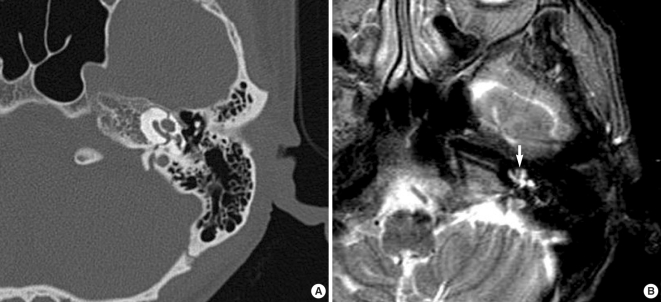Clin Exp Otorhinolaryngol.
2008 Sep;1(3):171-173. 10.3342/ceo.2008.1.3.171.
Cochlear Implantation after Bilateral Transverse Temporal Bone Fractures
- Affiliations
-
- 1Department of Otolaryngology, Daegu Fatima Hospital, Daegu, Korea. sungheekim@fatima.or.kr
- KMID: 1486090
- DOI: http://doi.org/10.3342/ceo.2008.1.3.171
Abstract
- Patients deafened by a severe head injury are rarely encountered. We report a case of a 65-yr-old man with bilateral transverse temporal bone fractures due to head injury. He underwent cochlear implant and achieved a satisfactory auditory rehabilitation. Imaging studies of temporal bone before performing a cochlear implantation provide important information on a patient with bilateral temporal bone fractures. Cochlear implantations with careful planning in such a patient may be a very effective method for aural rehabilitation.
MeSH Terms
Figure
Reference
-
1. Morgan WE, Coker NJ, Jenkins HA. Histopathology of temporal bone fractures: implications for cochlear implantation. Laryngoscope. 1994; 4. 104(4):426–432. PMID: 8164481.2. Camilleri AE, Toner JG, Howarth KL, Hampton S, Ramsden RT. Cochlear implantation following temporal bone fracture. J Laryngol Otol. 1999; 5. 113(5):454–457. PMID: 10505161.
Article3. Simons JP, Whitaker ME, Hirsch BE. Cochlear implantation in a patient with bilateral temporal bone fractures. Otolaryngol Head Neck Surg. 2005; 5. 132(5):809–811. PMID: 15886642.
Article4. Nadol JB Jr, Young YS, Glynn RJ. Survival of spiral ganglion cells in profound sensorineural hearing loss: implications for cochlear implantation. Ann Otol Rhinol Laryngol. 1989; 6. 98(6):411–416. PMID: 2729822.
Article5. Fredrickson JM, Griffith AW, Lindsay JR. Transverse fracture of the temporal bone. A clinical and histopathologic study. Arch Otolaryngol. 1963; 12. 78:770–784. PMID: 14059364.
- Full Text Links
- Actions
-
Cited
- CITED
-
- Close
- Share
- Similar articles
-
- Cochlear Implantation in a Deaf Patient with Bilateral Temporal Bone Fractures
- A Case of Cochlear Implantation after Bilateral Temporal Bone Fracture
- A Case of Cochlear Implantation Targeting Preserved Cerebral Cortex in Severe Traumatic Brain Injury
- A Case of Cochlear Implantation in a Postligual Deaf Patient with Osteogenesis Imperfecta
- Cochlear Implantation in the Cochlear Nerve Hypoplasia or Aplasia as Suggested by Temporal Bone Magnetic Resonance Imaging



